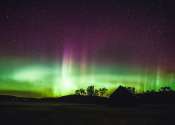With Solar Cycle 25 still peaking, what sights, threats experts expect
In May, powerful solar storms delivered stunning auroras to latitudes that rarely experience them. Light shows were seen as far south as Florida and Texas, while more northerly areas of the United States were treated to spectacular ...









